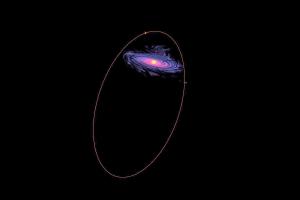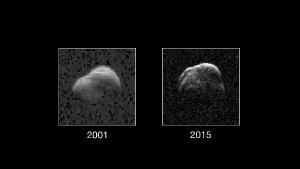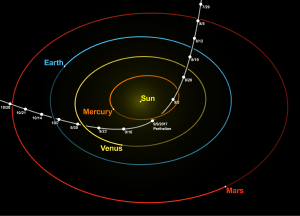Blog
Alien Invasion
28 July 2020
 Namouni and Morais, NASA
Namouni and Morais, NASAAliens could be all around us. Lurking on the edge, waiting to invade our solar system. Not little green creatures, but asteroids from other stars. That’s the conclusion of a new study published in the Monthly Notices of the Royal Astronomical Society.1
The outer solar system is filled with asteroids and comets. Most of them formed as a part of the solar system about 4.5 billion years ago. They tend to have stable orbits, though a rare interaction might fling them out of the solar system, or send them tumbling toward the inner solar system. But there are some outer solar system bodies that are a bit unusual.
 NASA/JPL-Caltech/GSSR/NRAO/AUI/NSF
NASA/JPL-Caltech/GSSR/NRAO/AUI/NSFOne such group is known as Centaurs. They are asteroids with orbits that cross between Jupiter and Neptune. Over a timescale of about 100 million years, the realm of Centaurs is unstable. That’s because they have a high chance of passing close to one of the gas giants and having their orbit deflected. Centaurs might even be a significant source of terrestrial impacts since they could often be deflected in our direction.
It is the instability of their orbits that also makes Centaurs a mystery. Since they don’t have long-term stable orbits, they can’t have formed in that region with the rest of the solar system. It’s possible that they formed elsewhere and migrated to that region, but that seems unlikely given how many there are. So astronomers have proposed another idea that Centaurs could have originated outside our solar system.
 Tom Ruen, CC BY-SA 4.0
Tom Ruen, CC BY-SA 4.0One point of evidence to support this idea is that some Centaur asteroids have highly inclined orbits. Rather than orbiting the Sun in the same general plane as the planets and most asteroids, these Centaurs have orbits that are nearly perpendicular rest of the solar system. Since solar system bodies formed as part of a planetary disk, these Centaurs could not have formed in high-inclination orbits. So they were deflected there by interactions with other bodies, or they are interstellar objects captured by the solar system.
To answer this mystery, Fathi Namouni and M. H. M. Morais calculated the orbits of 19 high-inclination Centaurs backward in time to see whether their orbits might be unstable. They found these Centaurs have extremely stable orbits that could last for the entire age of the solar system. They could not have formed in the common plane of the solar system and have their orbits perturbed into a high angle. This strongly supports the idea that they are interstellar in origin.
We know that interstellar bodies visit our solar system. The asteroid Oumuamua, for example, had such a high orbital speed that it must have been an interstellar body. Oumuamua also had a highly inclined orbit, which is what you would expect. Since interstellar bodies could come from any direction, it is much more likely that they would have a highly inclined trajectory.
This study doesn’t prove that all Centaurs are alien visitors. However, it shows that the outer solar system could be filled with asteroid visitors from other stars.
Namouni, Fathi, and M. H. M. Morais. “An interstellar origin for high-inclination Centaurs.” Monthly Notices of the Royal Astronomical Society 494.2 (2020): 2191-2199. ↩︎